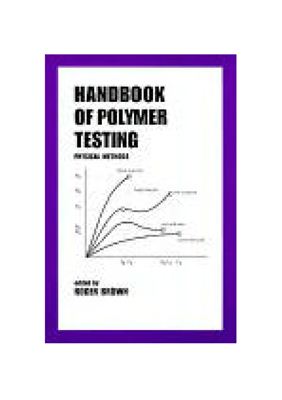1999, Marcel Dekker Inc. , 860 р.
Handbook of Polymer Testing provides in one volume that comprehensive coverage of physical test methods for polymers. The properties considered cover the whole range of physical parameters, including mechanical, optical, electrical, and thermal as well as resistance to degradation, nondestructive testing, and tests for processability. All the main polymer classes are included: rubbers, plastics, foams, textiles, coated fabrics, and composites. For each property, the fundamental principles and approaches arc discussed and particular requirements and the relevant inteational and national standards for the different polymer classes considered, together with the most-up-to-date techniques.
This book will be of particular value to materials scientists and technologists, and to all those who need to evaluate a spectrum of polymeric materials, including students, design engineers, and researchers. Its structure allows reference for the main properties at both the general and the detailed level, thus making it suitable for different levels of knowledge.
Chapter 29 is based on material produced for the Testing Knowledge Base" at Rapra Technology. Ltd. Extracts from British Standards were reproduced with the permission of BSI. Users of standards should always ensure that they have complete and current infor-mation. Standards can be obtained from BSI Customer Services. 389 Chiswick High Road. London W4 4AL, England.
Handbook of Polymer Testing provides in one volume that comprehensive coverage of physical test methods for polymers. The properties considered cover the whole range of physical parameters, including mechanical, optical, electrical, and thermal as well as resistance to degradation, nondestructive testing, and tests for processability. All the main polymer classes are included: rubbers, plastics, foams, textiles, coated fabrics, and composites. For each property, the fundamental principles and approaches arc discussed and particular requirements and the relevant inteational and national standards for the different polymer classes considered, together with the most-up-to-date techniques.
This book will be of particular value to materials scientists and technologists, and to all those who need to evaluate a spectrum of polymeric materials, including students, design engineers, and researchers. Its structure allows reference for the main properties at both the general and the detailed level, thus making it suitable for different levels of knowledge.
Chapter 29 is based on material produced for the Testing Knowledge Base" at Rapra Technology. Ltd. Extracts from British Standards were reproduced with the permission of BSI. Users of standards should always ensure that they have complete and current infor-mation. Standards can be obtained from BSI Customer Services. 389 Chiswick High Road. London W4 4AL, England.

